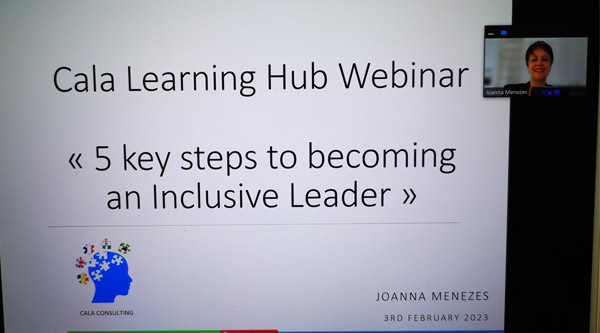#MeToo, #BlackLivesMatter... These grass-roots movements have shaken up society in recent years, including in companies. Progressively, companies are becoming more and more aware of the importance of D&I and are changing their strategies and practices. But what exactly is diversity and inclusion? What do companies stand to gain? And, most importantly, how can we foster an inclusive work environment? On 5th February 2021, Joanna Menezes, certified coach, trainer and founder of the Cala Learning Hub network, took stock of these questions during a webinar that brought together some twenty professionals from all walks of life.
No Diversity without Inclusion
In our globalised world, companies have evolved and are now more than ever composed of employees from different cultures, generations, genders, experiences and social backgrounds... That's diversity! "And these companies, like their employees, have a lot to gain," Joanna Menezes explains at the outset. Among the benefits? Diversity of thought, greater creativity, an increased capacity to solve problems... In short, better performance and, ultimately, higher financial returns.
But this diversity can also be a source of misunderstanding and conflict within teams and give rise to an increase in the risk of harassment and discrimination... All of which are delicate situations that the company must address... This is why "there is no diversity without inclusion," says Joanna Menezes. It is even the key component to success! ". To understand this, let's go back to the exact definition of inclusion: it is the act of creating environments in which every individual can feel welcomed, respected, supported and valued. Because people work better when they can truly be themselves.
"Diversity is being invited to the party, inclusion is being asked to dance »
(Verna Myers, American D&I expert)
7 steps to creating an inclusive work environment
So how do you create that inclusive work environment in which employees can thrive professionally? Here are the 7 key steps:
- Inspire the movement from the top: by ensuring diversity in leadership and appointing a Chief Diversity Officer for example;
- Make a written commitment: by making the commitment to D&I visible in the company's values and by signing the Diversity Charter for example;
- Seek employee input: by asking, through surveys or informal focus groups, about the perceived inclusivity of the company culture and taking action to address employee concerns;
- Creating an inclusive workspace: making the workplace accessible to people with disabilities or special needs, for example a breastfeeding room;
- Designing inclusive policies and procedures: ensuring that at all stages of the employee life cycle, no one is left out;
- Having inclusive language: e.g. by encouraging inclusive writing;
- Challenging behaviours and promoting respect and tolerance: by offering training, coaching or mentoring.
A long-term process
There are indeed many tools to support managers and employees in becoming more inclusive. Among them, corporate training is a good way to raise awareness. For example, there are workshops on diversity and inclusion or unconscious bias. Coaching can also be very useful to take action: inclusive management coaching, co-development workshops for managers... Mentoring can also be very interesting to break the glass ceiling or to allow the inclusion of new employees...
"Inclusion is a long-term process, it does not happen overnight," warns Joanna. That's why you shouldn't get discouraged. With this advice in mind, some of the participants exchanged a few minutes and shared their respective experiences. Everyone left enlightened, inspired and, for some, determined to take action.








 Copyright © 2016 - 2025 - Cala Consulting
Copyright © 2016 - 2025 - Cala Consulting